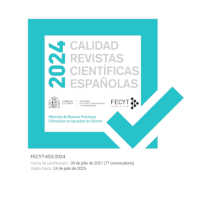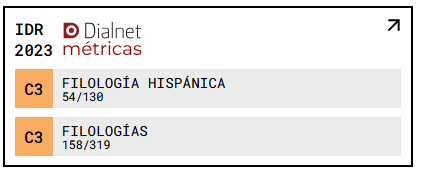Sonnets in "El mayor imposible" of Lope de Vega
DOI:
https://doi.org/10.18172/cif.4882Keywords:
Polymetry, sonnets, dramatic functionality, baroque theater, rewriting, Lope de VegaAbstract
To the extent that Lope de Vega introduced a large number of sonnets in his plays, unlike the rest of the playwrights of his time, this article carries out a study of the dramatic functionality of the sonnets of El mayor imposible, in an attempt to explain its prominent role in the rest of the dramatic fabric, the themes it houses, always in close connection with the keys of the plot, the different discursive forms it adopts and the procedures for structuring the content it uses, as well as other functions and meanings that they acquire both in the dramatic and in the extraliterary context.Downloads
References
ALCIATO, A. (1993). Emblemas. (Ed. Santiago Sebastián). Madrid: Akal.
APOLONIO DE RODAS (1996). Las Argonáuticas. Madrid: Gredos.
CRUZ, S. J. de la (1984). Poesía. (Ed. Domingo Ynduráin). Madrid: Cátedra.
CURTIUS, E. R. (1995). Literatura europea y Edad Media Latina (I). Madrid: Fondo de Cultura Económica.
DELANO, L. K. (1935). A critical index of sonnets in the plays of Lope de Vega. Toronto: The University Press.
DI PINTO, E. (2010) “El arte de la ‘refundición’ según Moreto (II): “El mayor imposible”, de Lope de Vega, vs. ‘No puede ser’, de Moreto”. Cuatrocientos años del “Arte nuevo de hacer comedias” de Lope de Vega: actas selectas del XIV Congreso de la Asociación Internacional de Teatro Español y Novohispano de los Siglos de Oro. Olmedo, 20 al 23 de julio de 2009 (II). (Coords. Germán Vega García-Luengos y Héctor Urzáiz Tortajada. Recurso electrónico: 409-416.
GRIMAL, P. (1994). Diccionario de mitología griega y romana. Barcelona: Paidós.
GÜNTERT, G. (2011). “Función del soneto en el teatro áureo: ¿pausa reflexiva del personaje o tematización del drama?”. El espacio del poema. Teoría y práctica del discurso poético. (Eds. Itziar López Guil y Jenaro Talens). Madrid: Biblioteca Nueva: 205-223.
HESÍODO (1978). Teogonía. (Eds. Aurelio Pérez Jiménez y Alfonso Martínez Díez). Madrid: Gredos.
HIGINO (2009). Fábulas. (Eds. Javier del Hoyo y José Miguel García Ruiz). Madrid: Gredos.
LEFEBVRE, A. (1963). “Guía de las noches de Lope”. Mapocho (1). 253-261.
MANERO SOROLLA, M.ª P. (1990). Imágenes petrarquistas en la lírica española del Renacimiento. (Repertorio). Barcelona: PPU.
MARÍN, D. (1968). Uso y función de la versificación dramática en Lope de Vega. Valencia: Castalia.
MORLEY, G. S. y BRUERTON, C. (1968). Cronología de las comedias de Lope de Vega. Con un examen de las atribuciones dudosas, basado todo ello en un estudio de su versificación estrófica. (Ed. María Rosa Cartes). Madrid: Gredos.
PLINIO EL VIEJO (2003). Historia naturalis (VII-IX). (Eds. de E. del Barrio Sanz, I. García Arribas, A. M.ª. Moure Casa, L. A. Hernández Miguel, M.ª L. Arribas Hernández. Madrid: Gredos.
SÁNCHEZ JIMÉNEZ, A. (2012). “La poética de la noche en siete sonetos apelativos de Lope de Vega”. Ehumanista (22): 357-374.
SÁNCHEZ JIMÉNEZ, A. (2014). “Otro soneto apelativo a la noche en Lope de Vega: El príncipe perfecto (c.1612-1614)”. Ehumanista (27): 407-414.
VEGA CARPIO, L. de (2014). El alcalde mayor. (Ed. José Enrique López Martínez). Comedias de Lope de Vega. Parte XIII (Coord. Natalia Fernández Rodríguez). Madrid: Gredos. II: 3-164.
VEGA CARPIO, L. de (1965). El capellán de la Virgen. Obras de Lope de Vega. Comedias de santos II. (Ed. Marcelino Menéndez Pelayo). Madrid: Atlas. X: 273-323.
VEGA CARPIO, L. de (2005). El mármol de Felisardo. (Eds. de Beatriz Aguilar y Benet Marcos). Comedias de Lope de Vega. Parte VI. (Coords. Victoria Pineda y Gonzalo Pontón). Lérida: Milenio-UAB. III: 1571-1702.
VEGA CARPIO, L. de (1930). El mayor imposible. Obras de Lope de Vega publicadas por la RAE (Nueva edición). Obras dramáticas. (Ed. Emilio Cotarelo y Mori). Madrid: RAE. XII: 581-616.
VEGA CARPIO, L. de (1934). El mayor imposible. (Ed. John Brooks). Tucson: University of Arizona.
VEGA CARPIO, L. de (1930). Los muertos vivos. Obras de Lope de Vega publicadas por la Real Academia Española (Nueva edición). Obras dramáticas. (Eds. Emilio Cotarelo y Mori). Madrid: RAE. VII: 639-680.
VEGA CARPIO, L. de (1993). Rimas (I). (Ed. Felipe B. Pedraza Jiménez). Madrid: Universidad de Castilla-La Mancha.
TITO LIVIO (1993). Historia de Roma desde su fundación (XXXVI-XL). (Ed. de José Antonio Villar Vidal). Madrid: Gredos.
Downloads
Published
How to Cite
Issue
Section
License
Copyright (c) 2020 Raquel Carmen Nieto Moreno de Diezmas

This work is licensed under a Creative Commons Attribution 4.0 International License.
The authors retain copyright of articles and authorize CIF the first publication. They are free to share and redistribute the article without obtaining permission from the publisher as long as they give appropriate credit to the editor and the journal.
Self-archiving is allowed too. In fact, it is recommendable to deposit a PDF version of the paper in academic and/or institutional repositories.
It is recommended to include the DOI number.
This journal is licensed under a Creative Commons Attribution 4.0 International License














